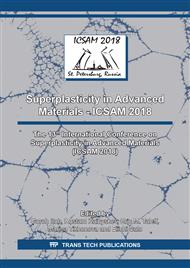[1]
R.Z. Valiev, Y. Estrin, Z. Horita, T.G. Langdon, M.J. Zehetbauer, Y.T. Zhu, Producing bulk ultrafine-grained materials by severe plastic deformation, 58(4) JOM (2006) 33-39.
DOI: 10.1007/s11837-006-0213-7
Google Scholar
[2]
R.Z. Valiev, T.G. Langdon, Principles of equal-channel angular pressing as a processing tool for grain refinement, Prog. Mater. Sci. 51 (2006) 881-981.
DOI: 10.1016/j.pmatsci.2006.02.003
Google Scholar
[3]
A. P. Zhilyaev, T. G. Langdon, Using high-pressure torsion for metal processing: Fundamentals and applications, Prog. Mater. Sci. 53 (2008) 893-979.
DOI: 10.1016/j.pmatsci.2008.03.002
Google Scholar
[4]
T.G. Langdon, A unified approach to grain boundary sliding in creep and superplasticity, Acta Metall. Mater. 42 (1994) 2437-2443.
DOI: 10.1016/0956-7151(94)90322-0
Google Scholar
[5]
S. Shim, J.-i. Jang, G.M. Pharr, Extraction of flow properties of single-crystal silicon carbide by nanoindentation and finite-element simulation, Acta Mater. 56 (2008) 3824-3832.
DOI: 10.1016/j.actamat.2008.04.013
Google Scholar
[6]
M. Kawasaki, T.G. Langdon, Grain boundary sliding in a superplastic zinc-aluminum alloy processed using severe plastic deformation, Mater. Trans. 49 (2008) 84-89.
DOI: 10.2320/matertrans.me200720
Google Scholar
[7]
M. Kawasaki, T.G. Langdon, Developing superplasticity and a deformation mechanism map for the Zn–Al eutectoid alloy processed by high-pressure torsion, Mater. Sci. Eng. A 528 (2011) 6140-6145.
DOI: 10.1016/j.msea.2011.04.053
Google Scholar
[8]
K. Higashi, M. Mabuchi, T.G. Langdon, High-strain-rate superplasticity in metallic materials and the potential for ceramic materials, ISIJ Intl. 36 (1996) 1423-1438.
DOI: 10.2355/isijinternational.36.1423
Google Scholar
[9]
M. Kawasaki, T.G. Langdon, Review: achieving superplastic properties in ultrafine-grained materials at high temperatures, J. Mater. Sci. 51 (2016) 19–32.
DOI: 10.1007/s10853-015-9176-9
Google Scholar
[10]
P.H.R. Pereira, Y. Huang, M. Kawasaki, T.G. Langdon, An examination of the superplastic characteristics of Al–Mg–Sc, alloys after processing, J. Mater. Res. 22 (2017) 4541-4553.
DOI: 10.1557/jmr.2017.286
Google Scholar
[11]
I.-C. Choi, Y.-J. Kim, B. Ahn, M. Kawasaki, T.G. Langdon, J.-I. Jang, Evolution of plasticity, strain-rate sensitivity and the underlying deformation mechanism in Zn-22% Al during high-pressure torsion, Scripta Mater. 75 (2014) 102-105.
DOI: 10.1016/j.scriptamat.2013.12.003
Google Scholar
[12]
M. Furukawa, Z. Horita, M. Nemoto, R.Z. Valiev, T.G. Langdon, Fabrication of submicrometer-grained Zn-22% Al by torsion straining, J. Mater. Res. 11 (1996) 2128-2130.
DOI: 10.1557/jmr.1996.0270
Google Scholar
[13]
M. Furukawa, Y. Ma, Z. Horita, M. Nemoto, R.Z. Valiev, T.G. Langdon, Microstructural characteristics and superplastic ductility in a Zn-22% Al alloy with submicrometer grain size, Mater. Sci. Eng. A241 (1998) 122-128.
DOI: 10.1016/s0921-5093(97)00481-4
Google Scholar
[14]
T. Tanaka, H. Watanabe, M. Kohzu, K. Higashi, Microstructure and superplastic properties at room temperature in Zn-22Al alloy after equal-channel-angular extrusion, Mater. Sci. Forum 447-448 (2004) 489-496.
DOI: 10.4028/www.scientific.net/msf.447-448.489
Google Scholar
[15]
P. Kumar, C. Xu, T.G. Langdon, The significance of grain boundary sliding in the superplastic Zn–22% Al alloy after processing by ECAP, Mater. Sci. Eng. A 410–411 (2005) 447-450.
DOI: 10.1016/j.msea.2005.08.092
Google Scholar
[16]
T.G. Langdon, Seventy-five years of superplasticity: historic developments and new opportunities, J. Mater. Sci. 44 (2009) 5998-6010.
DOI: 10.1007/s10853-009-3780-5
Google Scholar
[17]
M. Kawasaki, B. Ahn, P. Kumar, J.-i. Jang, T.G. Langdon, Nano- and micro-mechanical properties of ultrafine-grained materials processed by severe plastic deformation techniques, Adv. Eng. Mater. 19 (2017) 1600578(1-17).
DOI: 10.1002/adem.201600578
Google Scholar
[18]
T. Uesugi, M. Kawasaki, M. Ninomiya, Y. Kamiya, Y. Takigawa, K. Higashi, Significance of Si impurities on exceptional room-temperature superplasticity in a high-purity Zn-22%-Al alloy, Mater. Sci. Eng. A 645 (2015) 47-56.
DOI: 10.1016/j.msea.2015.07.087
Google Scholar


